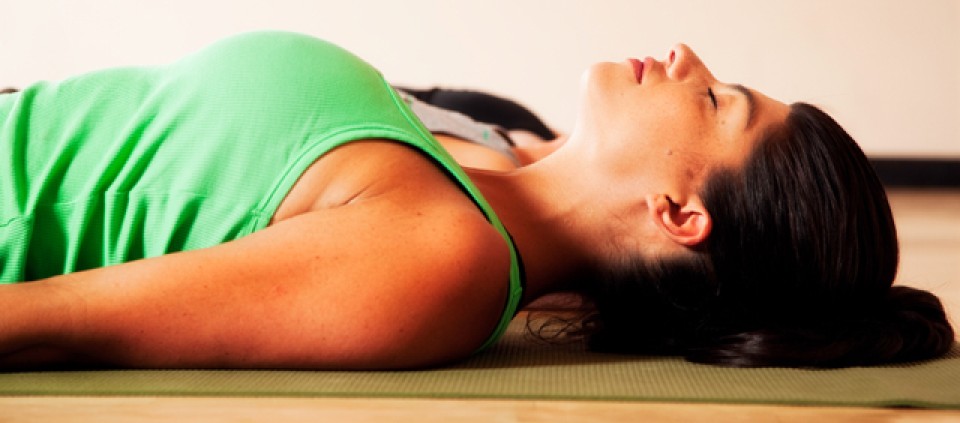Yoga Nidra: Power Yoga of the Mind

by Susan Abbattista
One of my favorite vinyasa yoga teachers once said, “If dropping into stillness is the hardest thing for you to do, then that is what you need the most.” And so, sometime around the first frost, I came to Kripalu to try a meditative practice called yoga nidra. Translated as “yogic sleep” or “divine sleep,” this type of yoga focuses on the systematic relaxation of the body while the mind enters a state of deep, meditative awareness—like dreaming while fully awake. The technique was developed by Swami Satyananda in the 1960s to make advanced, centuries-old practices of tantric meditation more accessible to everyone.
I’d never done this type of yoga before and didn’t quite know what to expect. One thing I did know: Underneath my blanket, I was an exhausted mess. Summer had passed in a hazy blur of work and play—and, admittedly, too many margaritas. Now here it was, the onset of fall, the hardest seasonal transition for me. I felt myself floating and drifting, a balloon accidentally released from the fist of a child. I needed to reel myself back in.
Over the course of five days, some unspoken guidelines (or pointers) emerged from the darkness:
Stay awake if you can. “Divine sleep” is really not about sleeping (though you might). In this ultra-relaxed state of consciousness, your mind is focused, fully alert, and receptive. This experience is sometimes called the relaxation response, where deep healing and regeneration can happen.
Don’t worry if you can’t relax at first. You may find that divine sleep may not feel too, well, divine. For me, it was a slow process of trusting and letting go. In fact, for the first two days, I felt like an egg sitting on the edge of a kitchen counter. My back ached. If I really let myself relax to the core, would I smash to the ground? And would I be able to clean up the mess afterward?
Trust the flow. It can seem formless and passive, but the ancient practice of yoga nidra is as systematic as most any other yoga flow. There is a basic sequence: Get comfortable; set an intention for your practice; relax each part of the body; take a guided journey (maybe it’s a forest, field of sage, or warm beach); see what you see; feel what you feel; repeat your intention; return to your self. On a deeper level, the sequence moves you through all layers (called koshas) of your consciousness—physical, energetic, mental, emotional, and spiritual. When you’re done, as in other practices, you feel as though you’ve landed in a different place from where you started. You know yourself a little better.
What makes this yoga so powerful, in my opinion, is summed up by one word: vision. Not just everyday vision but ultra-vivid perception, like suddenly having a lens that magnifies your moment-by-moment experience. Sometimes the lens is tightly focused on the tiny details; other times, it’s a wide-angle view that takes in everything. This is the power of the focused gaze, or drishti, as it is called in Sanskrit. It resonates on many levels.
Inner vision. In the deepest depths of yoga nidra, a film plays out in the darkness of your mind. And like studying an abstract piece of art, you may see signs, symbols, or metaphors. You close your eyes and gaze into your heart. You find words there, like “freedom.” You see symbols. A turtle retracted inside its shell. The stop sign that actually says GO. The picnic table from your childhood. The backyard of your first home. The tablecloth your mother used for company. You see the faces of people who have passed on. Your uncle handing you change from his pocket. Your small, outstretched hand. Your father giving you his blessing: “Be happy.” You see the elements of your life that resonate most. The things that make you, you.
Outward vision. After doing this for a few days, you start to have a different view of everything around you. The world moves more slowly, and so do you. You see the autumn leaves in exquisite detail—sad and beautiful at once. Bands of color stretch across the mountains, banners of change. You decide to sit outside for awhile. Two rabbits emerge from the bushes. They munch on the grass at your feet, unafraid. You see for the first time the gentle curve of their glassy eyeballs, and your reflection bending along the shiny arcs. It fills you with a complicated feeling, hard to name. Something like gratitude mixed with longing.
Soft vision. By the fifth day, you see yourself, and others, with more gentleness. You realize everyone is searching for the same thing. You watch yourself heading back down the long driveway at Kripalu. You take a breath. You watch yourself wondering “What now?” You feel yourself at a crossroads. You remember the stop sign with GO written on it. You see very clearly how, in life, you always hold yourself back a little. And how it may be time to let go of the reins. Yes. Let go.
As Swami Kripalu once said, “Observation without judgment is the highest form of spiritual practice.” I would have to agree. But I would say it this way: Become a cosmic fly on the wall of your own experience. Trust what you see.
Learn more about yoga nidra programs at Kripalu.
Susan Abbattista is a writer, editor, and copywriter whose work has appeared in Boston magazine, Fast Company, The Improper Bostonian, and other publications.
© Kripalu Center for Yoga & Health. All rights reserved. To request permission to reprint, please email editor@kripalu.org.